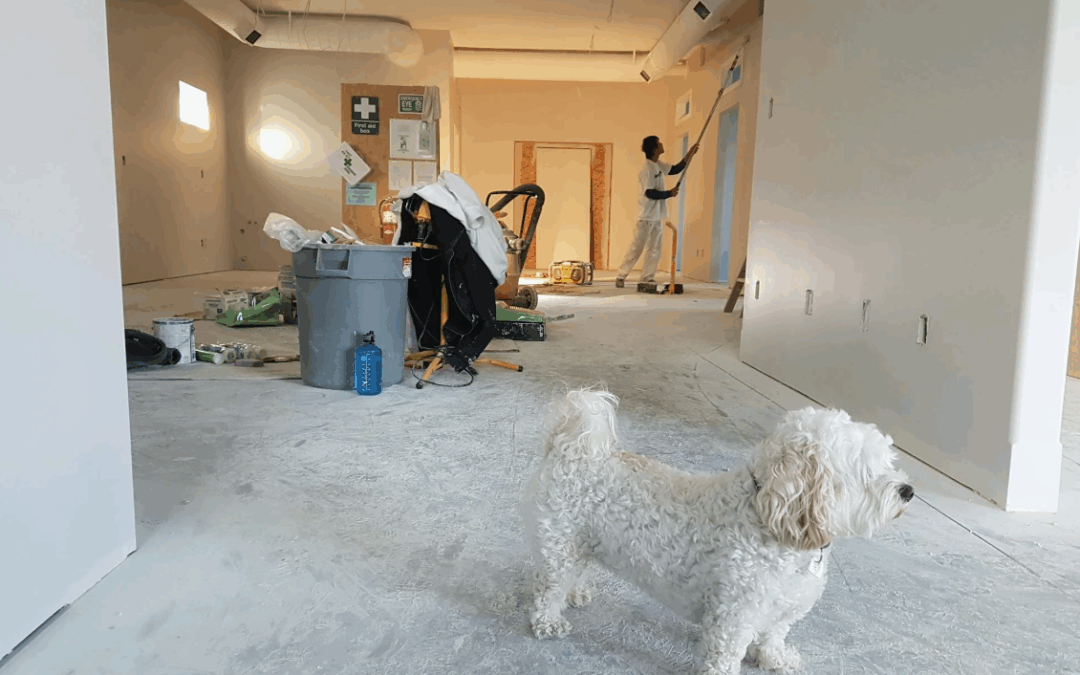
by Kanimozhi BV | May 14, 2025 | Home & Living
Renovating your home can be thrilling, but it’s often a challenging process with tough decisions and unexpected surprises. Every homeowner knows the anxiety that comes with wondering whether the vision in their mind matches what they’ll see once renovations are complete. This is precisely why 3D architectural visualization and 3D rendering services have become game-changers in home renovation.
With these digital tools, homeowners can visualize their dream spaces long before construction begins, relieving them of anxiety and costly mistakes. If you’ve ever struggled to explain your ideas clearly to a contractor or worried about expensive last-minute changes, these services are here to make your life easier.
The Importance of Accurate Planning in Home Renovations
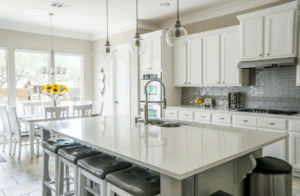
Let’s face it—excellent renovations don’t happen by accident. They require meticulous planning, clear communication, and precise execution. Skipping proper planning might save time initially, but it always costs more.
This is where accurate visual planning becomes essential. Using professional 3D architectural rendering services, homeowners can see exactly how their spaces will look post-renovation, gaining a sense of control over the process. By previewing realistic representations, it’s possible to pinpoint issues before construction begins, preventing costly adjustments down the road. It’s not just about avoiding mistakes; accurate planning ensures you get the home you envisioned.
Understanding 3D Rendering Services
What exactly do we mean by 3D rendering services? These are detailed digital representations of your home or a specific space created using specialized software. Talented artists at a 3D rendering firm or a dedicated 3D visualization studio combine exact measurements with textures, lighting, and realistic materials to create lifelike visualizations.
You can virtually walk through your future living room, kitchen, or bathroom and experience the completed design before a single hammer hits a nail. It’s like getting a glimpse into the future of your home, eliminating guesswork and uncertainty.
How 3D Rendering Works
Creating a realistic 3D render involves several detailed steps. Initially, the team from your chosen 3D architectural visualization company will collect precise dimensions and images of your existing home. Designers then use specialized software like 3ds Max, SketchUp, or Blender to build an accurate digital model. Next, they apply textures, colors, furniture, and lighting effects to mimic reality closely.
The final step involves sophisticated rendering algorithms to produce stunning images or animations, providing a photo-realistic preview of your upgraded home. It’s a fascinating blend of technology, creativity, and meticulous detail.
Benefits of 3D Rendering in Home Renovations
The benefits of using 3D render services are immediate and impactful. You can experiment with various designs, materials, and color schemes without any physical changes, saving time and money.

This approach gives homeowners confidence, as they clearly understand the outcome, drastically reducing anxiety and uncertainty. Moreover, these visualizations significantly enhance the accuracy of estimates provided by contractors, helping you manage your budget effectively.
Enhancing Communication with Contractors
Have you ever felt frustrated explaining your renovation ideas to a contractor? Miscommunication can lead to delays, unexpected costs, and disappointing results. Thankfully, 3D rendering services create a clear visual language that both homeowners and contractors can understand easily.
Instead of vague descriptions, you can provide a precise visual reference. This visual clarity bridges communication gaps ensure everyone is aligned, and greatly enhances collaboration between you and your renovation team.
Streamlining the Decision-Making Process
Decision fatigue during renovations is real. With endless choices—tiles, flooring, colors, lighting—homeowners often become overwhelmed. Thankfully, 3D visualizations simplify this process, providing relief from decision fatigue.
Presenting various options clearly and visually, these renderings help you see the effects of different decisions instantly. This clarity speeds up decision-making, removes doubts, and allows you to confidently finalize choices without second-guessing yourself later.
Cost-Effectiveness of 3D Rendering Services
While hiring a professional 3D rendering agency costs money, it’s an investment rather than an expense. By pinpointing potential issues beforehand, homeowners avoid costly last-minute alterations. Clear visualizations help prevent material wastage, reduce labor costs, and eliminate expensive mid-project changes. Thus, using 3D visualization services translates into significant long-term savings, making it an economically wise choice.
Case Study: A Successful Renovation Using 3D Rendering
Take, for example, a family planning a significant kitchen renovation. Initially uncertain about layout choices, materials, and overall aesthetics, they hired a reputable 3D rendering company. The digital renderings allowed them to experiment with several layouts, cabinetry designs, and lighting plans.
After reviewing these realistic visualizations, the family confidently selected an open layout, modern cabinets, and specific fixtures, knowing exactly how their new kitchen would look. The renovation proceeded smoothly, finished on time, within budget, and precisely matched the visualized designs. This scenario perfectly highlights how effective 3D rendering can ensure successful home upgrades.
Choosing the Right 3D Rendering Service
When selecting your 3D rendering partner, consider experience, reputation, and clarity in communication. Review their portfolio carefully to ensure their style matches your vision. Also, discuss their software expertise, turnaround times, and pricing transparency. The right partner will actively collaborate with you, bringing your ideas to life with precision and enthusiasm, ensuring your renovation is a complete success.
Tips for Maximizing the Value of 3D Rendering
- Communicate Clearly: Share detailed ideas, inspirations, and concerns openly.
- Set a Realistic Budget: Clearly outline budget constraints from the start.
- Review Iteratively: Provide feedback regularly to fine-tune visualizations.
- Consider Future Needs: Plan for long-term practicality alongside immediate needs.
- Validate with Professionals: Ensure contractors review renderings for feasibility.
Conclusion
Using 3D rendering services in home renovation projects transforms uncertainty into clarity. Whether working with a dedicated 3D visualization studio or opting for specialized 3D architectural rendering services, these tools provide confidence, streamline processes, and save money.
From enhanced communication to better budgeting, incorporating these visualizations makes home renovations brighter, smoother, and more successful. If you’re considering upgrading your home, it’s time to experience firsthand the transformative impact of professional 3D rendering services.

by Kanimozhi BV | May 14, 2025 | Washing Machine, Appliances
If you’ve ever stood puzzled in front of your Hotpoint washing machine wondering “Where is the filter on a hotpoint washing machine hiding?”, you’re not alone. I’ve been there myself, and trust me, it’s not always obvious.
Locating the filter is the first essential step before you can clean it properly—or even understand what might be going wrong with your washer.
In this guide, I’ll walk you through how to spot the filter on your Hotpoint washing machine, especially if you’re in the UK where front-loading models are most common.
Why Should I Care About the Filter on My Hotpoint Washing Machine?
The filter on a Hotpoint washing machine is a small area but an important part of your washer.
It’s designed to catch fluff, lint, coins, hairpins, and other debris that can sneak into the drum of the washer during a wash cycle.
While the cleaning process is a whole topic on its own, it all starts with simply knowing where the filter is.
Missing this step can lead to drainage issues, unpleasant smells, or even error messages on the machine.

What Exactly Is the Filter and What Does It Do?
In simple terms, the washing machine filter acts as a barrier between the wash drum and the drain pump.
Its job is to trap any foreign objects or debris that might damage the pump or block the drain hose.
On most Hotpoint front-loading washers, this filter is manually accessible, allowing you to remove and clean it when needed.
So, if you’re experiencing any performance issues or just doing a bit of preventive checking, knowing where the filter is located is key.
Where Is the Filter on a Hotpoint Washing Machine?
Here’s the answer you’ve been searching for: The filter on most Hotpoint washing machines is located at the bottom front of the unit, behind a flap or kick-strip.
This is especially true for front-loading models, which are the most popular in UK households.
Let’s break it down further.
Identifying the Filter on Front-Loading Hotpoint Models
If you have a front-loading Hotpoint washer (which you likely do in the UK), follow these steps to find the filter:
- Have a look at the bottom front panel of your washing machine.
- Spot a small square or rectangular flap, typically on the right-hand side.
- Use your fingers to open the flap or gently insert a flathead screwdriver if it’s a bit stiff.
- Behind the flap, you’ll find the drain pump filter cap, which usually looks like a round dial or plug.
Tip: Place a towel underneath before opening the cap, as a small amount of water may spill out.
The filter cover panel is sometimes designed to blend in, so don’t be surprised if it’s hard to spot at first glance.

Locating the Filter on Top-Loading Hotpoint Models
Top-loading Hotpoint washing machines are less common in the UK, but if you have one, the filter might be in a different place. Here’s what to check:
- The filter might be placed at the backside of the machine, behind a removable rear panel.
- You’ll likely need a screwdriver to open the panel & you can access the filter.
- Some older top-load models even have a lint trap inside the drum or under the agitator—though this is rare in Hotpoint units sold in the UK.
Your best bet is to refer to the Hotpoint user manual specific to your model for clarity.
How Do I Know I’ve Found the Filter?
You’ll recognise the filter by its round shape and removable cap. It often sits next to the drain hose and is sometimes labelled.
If you’ve removed the flap & found a circular dial or plug, you’ve likely found the Hotpoint washer filter.
It may have grooves for gripping, and once you unscrew it, you’ll typically see trapped lint, debris, or even small objects like coins inside.
But again, don’t open it just yet if you’re not ready to clean—it can release water.
When you’re ready to clean it, jump over to my full filter cleaning guide here – I cover it step-by-step.

Quick Comparison Table: Filter Location by Hotpoint Model Type
Here’s a quick reference to help you identify where the filter is based on your machine type:
| Model Type |
Filter Location |
How to Access |
Tools Needed |
| Front-Loading |
Bottom front panel |
Open kick-strip/flap |
None or flathead screwdriver |
| Top-Loading (if any) |
Rear panel (occasionally) |
Remove screws on back |
Screwdriver |
| Integrated/Compact |
Behind plinth or base cover |
Unscrew baseboard if needed |
None or basic tools |
Conclusion: Here’s Exactly Where to Find the Filter
So, where is the filter on a Hotpoint washing machine? In most UK models—especially the popular front-loaders—you’ll find it behind the small flap at the bottom front of the appliance.
It’s easy to miss, but once you know where to look, it takes just seconds to access.
When you’re ready to clean it, don’t forget to visit my detailed guide to cleaning the filter.
Keeping your filter clean not only helps your machine run more efficiently, but it can also save you from bigger repair costs down the road.

by Kanimozhi BV | May 12, 2025 | Wall, Bathroom, Interior
When I was redecorating my hallway, I found myself standing over a bucket of leftover wallpaper paste wondering: can you flush wallpaper paste down the toilet?
It seemed water-based, and it looked thin enough. But I hesitated—and I’m glad I did.
Here’s what I found out.
Why I Asked: Can You Flush Wallpaper Paste Down the Toilet?
At first glance, wallpaper paste looks harmless. It might be gloopy, yes, but it does dissolve in water, right?
That’s what I assumed too. Like many others, I figured if it mixes with water, it must be okay for the drains.
But I’ve learned the hard way that water-soluble doesn’t always mean drain-safe.
What Is Wallpaper Paste Made Of?
Wallpaper pastes are mostly made from modified starch, methylcellulose, or synthetic polymers. These ingredients help the paste become sticky when mixed with water.
Even if the packaging says it’s biodegradable or water-soluble, that doesn’t mean it will dissolve completely in your plumbing.
Instead, it can cling to the inside of your pipes, slow the flow, and catch other debris.

Can You Flush Wallpaper Paste Down the Toilet – Really?
After doing my research (and speaking to a plumber), the answer is clear: No, you should not flush wallpaper paste down the toilet.
Here’s why:
- It can thicken inside the pipes, especially if poured in large quantities.
- Over time, it builds up, attracting dust, hair, and other bits—leading to clogs and causes smell in bathroom.
- It’s not safe for septic tanks or shared sewage systems.
So while it may go down the toilet initially, it’s what happens further along the system that becomes a problem—and possibly a costly one.
What’s the Right Way to Dispose of Wallpaper Paste in the UK?
According to local council guidelines and waste experts, the safest method to dispose of wallpaper paste is simple: let it dry and bin it.
If you’ve got a small amount left, pour it into a cardboard box or container lined with newspaper and leave it to harden.
Once it’s solid, you can throw it away in your regular household rubbish.
For larger amounts, I’ve taken it to a household waste and recycling centre. They usually have clear instructions for disposing of DIY materials safely.

What I Do with Leftover Wallpaper Paste?
These days, I try to mix only what I need. But when I do have leftovers:
- I let the wallpaper paste dry out in a tub, then scrape it into the bin.
- I avoid pouring it down any drain—even a small amount.
- Occasionally, I share leftovers with a neighbour if they’re decorating too.
Not only does this prevent plumbing issues, but it also cuts down on unnecessary waste.
Disposal Methods Compared
| Method |
Is It Safe? |
Plumbing Risk |
Environmental Impact |
| Flushing down the toilet |
No |
High |
Negative |
| Pouring down sink drain |
No |
Moderate to High |
Negative |
| Bin disposal (dried paste) |
Yes |
None |
Low |
| Council hazardous waste centre |
Yes |
None |
Safest option |
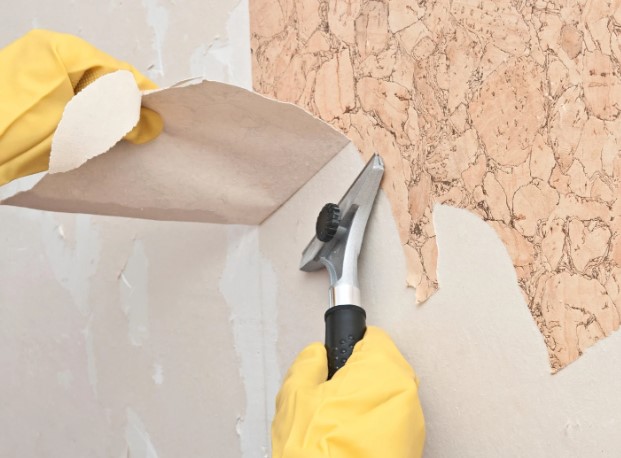
Conclusion: Here’s What I Learned the Hard Way
Trying to take the easy route by flushing wallpaper paste might seem harmless—but it’s not worth the risk. I’ve learned to:
- Always check local disposal guidelines
- Avoid flushing or draining paste
- Plan better to avoid waste in the first place
It’s a small habit that can save a lot of hassle—and money—down the line.
Related Article: How To Remove Brown Stains From Toilet Bowl?
FAQs on Disposing Wallpaper Paste
1. Can I dilute it and pour it down the drain?
Even diluted, it can still gum up the pipes. Best to avoid.
2. What if it’s already dried up?
If it’s dry as well as solid, then it is safe to put in the general waste bin.
3. Are eco-pastes any better?
Some are better for the environment—but not necessarily for your pipes. Still best to dispose of them carefully.
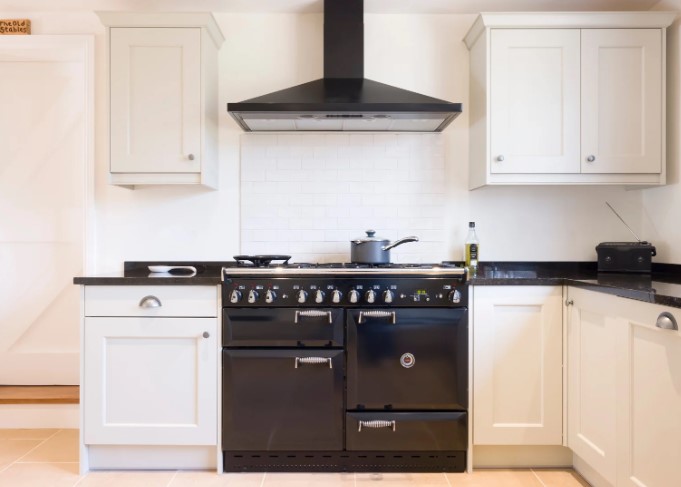
by Kanimozhi BV | May 12, 2025 | DIY Ideas, Home & Living
Need tips on how to clean cooker hood filter? Cleaning a cooker hood filter may not top anyone’s to-do list, but it’s essential for maintaining a clean and healthy kitchen.
I’ve learned that with a few smart, natural methods, tackling that sticky, greasy mess can be easier—and more satisfying—than you’d think.
Let me walk you through how I do it using simple ingredients and easy-to-follow steps.
Why Should I Clean My Cooker Hood Filter Regularly?
You might wonder, why do you have to clean kitchen hood filters at all?
Over time, filters collect grease, smoke, and food particles that reduce airflow and make your extractor fan work harder.
If ignored, the grime can affect your indoor air quality and even pose a fire risk.
From my experience, cleaning your cooker hood filter every couple of weeks—or monthly, depending on how often you cook—helps your kitchen stay fresh, your appliance run smoothly, and your bills stay lower.

The best part? You don’t need harsh chemicals.
I stick with natural effective ingredients you probably already have in your kitchen, like baking soda, white vinegar, lemon juice, and dish soap.
I also keep an old toothbrush handy for scrubbing, and a deep basin or sink to soak the filter in hot water.
These eco-friendly options work well on metal mesh and stainless steel filters, without damaging them.
Are Cooker Hood Filters Washable?
Yes—metal mesh filters, which are common in UK homes, are washable and designed for long-term use.
Just be careful with carbon or charcoal filters; those aren’t washable and should be replaced every few months instead.
If you’re unsure whether your filter is reusable, check the manufacturer’s guide or look for visible wear.
If it’s warped, crumbling, or permanently discoloured, it’s time for a replacement.
Metal mesh filters are durable but prone to grease buildup as in kitchen cupboards.
To clean them, I usually start by removing the filter and soaking it in a mix of hot water, baking soda, and white vinegar for about 20 minutes.
After that, a gentle scrub with a brush lifts off the residue. It’s important to rinse thoroughly and let it dry before placing it back.
Avoid using bleach or abrasive pads, especially on aluminium filters, which can scratch or corrode easily.
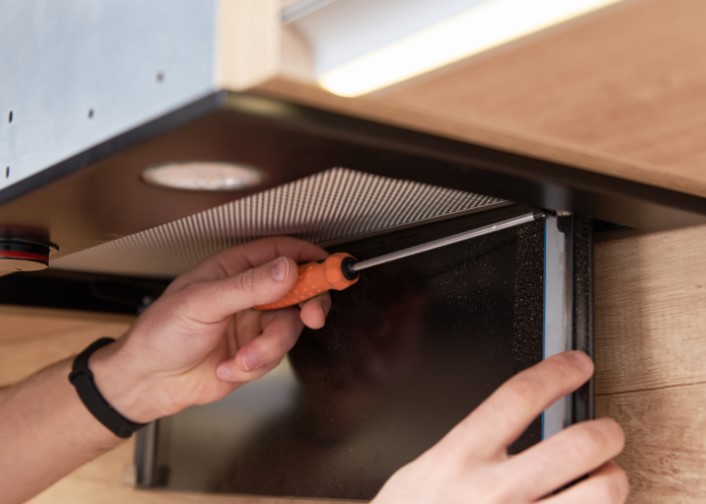
How to Clean Cooker Hood Filter? 5 Natural Smart DIY Ideas
What is the best way to clean range hood filters?
In my opinion, the baking soda and boiling water combo gives the best results.
But here are five natural, DIY methods I use based on how messy the filter is.
1. Baking Soda and Boiling Water
This is my go-to for heavy grease.
I fill a sink with boiling water, add a few tablespoons of baking soda, and let the filter soak. After 15–20 minutes, most of the grime wipes right off.
2. White Vinegar Soak
If I’m dealing with a stainless steel filter, I prefer a vinegar soak.
I add a cup or two of white vinegar to hot water and leave the filter in for 30 minutes. The vinegar naturally cuts through the grease without damaging the finish.
3. Lemon Juice Steam Cleaning
This method is best when I’m short on time.
I boil lemon slices in a pan of water under the hood and let the steam work its way through the filter. It’s not a deep clean, but it freshens things up nicely.
4. Eco Dish Soap and Hot Water
Sometimes, a good soak in hot water and eco-friendly dish soap does the trick.
I let it sit for about 20 minutes, then gently scrub with a brush to lift off the softened grease.
5. DIY Degreaser Spray
For quick upkeep, I make a spray using white vinegar, lemon juice, and a bit of essential oil.
A few spritzes after cooking and a quick wipe-down help prevent buildup in the first place.
What Type of Filter Do I Have and Does It Matter?
Knowing your filter type makes a difference.
Aluminium mesh filters are washable and need regular cleaning, while carbon or charcoal filters trap odours and need to be replaced every 3–6 months.
It’s also worth noting that stainless steel filters can handle stronger cleaning solutions than aluminium ones, which are more sensitive to acidic or abrasive products.
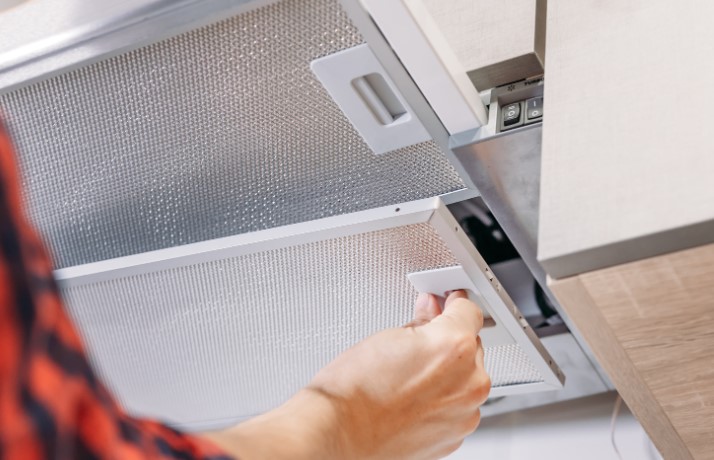
Pro Tips for Long-Term Cooker Hood Maintenance
Keeping your filter clean is only part of the job. I also make sure to cook with lids on pots to reduce splatter and wipe down the hood regularly.
If you start seeing grease accumulate again soon after cleaning, you might want to clean more frequently or consider replacing an old filter.
Summary Table: 5 DIY Methods Compared
| Method |
Best For |
Ingredients |
Soak Time |
b Needed |
| Baking Soda & Water |
Heavy grease |
Baking soda, boiling water |
15–20 min |
Yes |
| Vinegar Soak |
Stainless steel |
White vinegar, hot waterScru |
30 min |
Optional |
| Lemon Steam |
Quick freshening |
Lemon slices, water |
10 min |
No |
| Dish Soap & Hot Water |
General cleaning |
Dish soap, hot water |
20 min |
Yes |
| Degreaser Spray (DIY) |
Regular upkeep |
Vinegar, lemon juice |
N/A |
No |
Conclusion: Keep It Clean, Keep It Natural
A clean cooker hood filter means better air, better performance, and a better kitchen experience.
Whether it’s a quick lemon steam or a deep baking soda soak, there’s a method that fits your time and needs.
By choosing natural cleaners and regular upkeep, I’ve saved money, protected my appliance, and kept my home healthier. It is simple, satisfying & well worth the effort.
Related Article: How To Use a Brita Water Filter?
FAQs on How To Clean Cooker Hood Filter
1. Can I put my cooker hood filter in the dishwasher?
Yes, if it’s a metal mesh filter. Just avoid using high heat or harsh detergents, and don’t use the drying cycle of the dishwasher.
2. How do I know it’s clean enough?
I hold it up to the light—if I can see through it clearly, it’s clean.
3. Can I use bleach?
I don’t recommend it. Bleach can damage the filter material and leave behind harmful fumes.
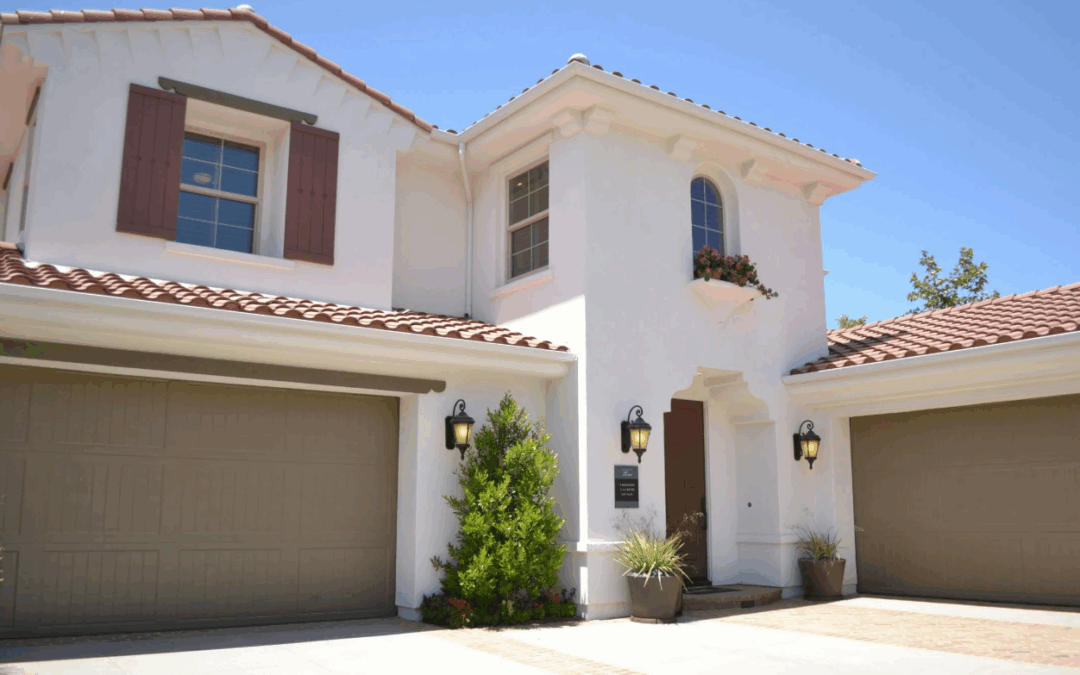
by Kanimozhi BV | May 12, 2025 | DIY Ideas
With remote working becoming the new norm for many, having a dedicated, quiet space to focus on work is essential. But carving out a perfect workspace in your home can be challenging if you’re short on spare rooms. That’s where the humble garage steps in! With a bit of creativity and organisation, your garage can transform into a fully functional and aesthetically pleasing home office.
This guide offers practical tips on how to design the perfect garage-turned-office without breaking the bank. From smart storage solutions to flooring ideas, here’s everything you need to know to make the most of the space you already have.
Declutter First, Design Later
Before anything else, decluttering is key. Garages are often hot spots for storing forgotten items, unused tools, or downright junk. Start by sorting through your belongings into three categories:
- Keep (items you regularly use)
- Donate/Sell (items in good condition but no longer needed)
- Discard (damaged or unusable items)
Be ruthless here! The less clutter you keep in your garage, the more space you’ll have for your future home office.
If you still need space for seasonal items (like Christmas decorations or garden tools), don’t worry. We’ll cover clever storage solutions below.
Get Organised with Smart Garage Storage Ideas

Once your space is cleared, it’s time to store remaining items in a way that doesn’t interfere with your new office zone. Here are some handy ideas for garage storage:
1. Install Shelving Systems
Wall-mounted shelving is your best friend. By using vertical space, you free up the floor for your desk and chair. Metal or heavy-duty wooden shelves are great for storing toolboxes, paint cans, or other bulky items.
2. Use Overhead Racks
Got a high ceiling? Overhead storage racks are perfect for items you won’t need daily, like camping gear or sports equipment.
3. Opt for Rolling Cabinets
For flexibility, invest in rolling storage cabinets. These can be tucked away when not needed and moved to another part of the house if your home office grows.
4. Add Hooks and Pegboards
Wall hooks and pegboards are a minimalist’s dream. They’re perfect for hanging bikes, tools, and other awkwardly shaped items that don’t fit on shelves.
By implementing these storage solutions, you can keep essential items neatly stored while maintaining plenty of open space for your office furniture.
Choose the Right Garage Flooring
Garages typically feature concrete floors, which don’t lend themselves to cosy home office vibes. The good news? Garage flooring upgrades can make a world of difference! Here are some great options to consider:
1. Epoxy Coating
Durable and easy to clean, epoxy-coated floors strike a perfect balance between functionality and style. They’re resistant to stains and come in a variety of colours to match your décor.
2. Interlocking Tiles
If insulation is a concern, interlocking tiles (like vinyl or rubber) are an excellent choice. They’re simple to install, soft underfoot, and perfect for soaking up noise if you have conference calls or online meetings.
3. Laminate or Engineered Wood Flooring
Want your new office to blend seamlessly into your home’s aesthetic? Laminate and engineered wood flooring bring warmth and comfort to your workspace. Just ensure proper sealing to protect against any dampness that may seep in.
4. Carpeting
For ultimate cosiness, consider outdoor/indoor carpets designed for garages. They’re hardy enough to handle the environment while adding a snug, homely touch to your workspace.
Set the Scene with Your Office Essentials

With the nitty-gritty out of the way, it’s time to bring your home office to life! Start by finding the essentials you need to stay comfortable and productive while working.
1. A Functional Desk and Chair
A sturdy desk and a supportive office chair should be at the top of your list. Look for ergonomic designs to keep you comfortable during long hours. If space is tight, consider wall-mounted desks or fold-down options.
2. Good Lighting
Garages are rarely flooded with natural light, so invest in quality lighting for your office. Layered lighting works well; LED overhead lights, desk lamps, or even string lights can all boost the visibility and ambience of your workspace.
3. Heating and Cooling Solutions
Depending on the season, garages can get uncomfortably cold or overly warm. Portable heaters, fans, or even a small split AC system can keep the temperature comfortable year-round.
4. Decorate Your Space
A personal touch can instantly turn a garage into a professional yet inviting office. Consider adding a rug, framed wall art, potted plants, or cork boards for pinning reminders.
Key Tips to Keep in Mind
- Ensure Proper Insulation: To truly transform your garage into a livable workspace, ensure walls, doors, and windows are properly insulated to reduce temperature fluctuations and noise.
- Maximise WiFi Strength: If your garage is far from your home’s router, consider a WiFi extender to ensure uninterrupted internet connectivity.
- Check Power Supply: Make sure your garage has sufficient power outlets for your computer, lighting, and other devices. Get a professional to assess your wiring if you’re planning major changes.
Make Your Garage Work for You
Turning your garage into a home office isn’t just about gaining space. It’s about creating an environment where creativity flows, productivity soars, and Zoom calls sound a lot nicer than at the dining table! By following this guide, you’ll have a beautiful, functional workplace that is separate from household distractions.
Are you ready to create the WFH setup of your dreams?


















